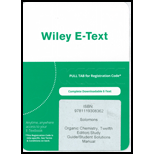
Concept explainers
Interpretation:
The chain reaction mechanism for the formation of
Concept introduction:
Radical halogenation is the reaction in which hydrogen atoms of
At normal temperature and pressure, chlorine and methane do not react with each other. The reaction is initiated by light or heat. When exposed to light,
The reaction that is initiated by light is more efficient because a very small amount of light photons allows a large number of products to be formed.
Want to see the full answer?
Check out a sample textbook solution
Chapter 10 Solutions
ORGANIC CHEMISTRY-ETEXT REG ACCESS
- Radical Mono-Chlorination of pentane is a poor way to prepare 1-chloropentane, but radical chlorination of neopentane, (CH3)4C, is a good way to prepare neopentyl chloride. Write an equation for both of these reactions and explain why this is. Pentane Neopentanearrow_forwardWhen tert-butyl bromide is heated with an equal amount of ethanol in an inert solvent, one of the products is ethyl tert-butyl ether. (a) What happens to the rate if the concentration of tert-butyl bromide is tripled and the concentration of ethanol is doubled?arrow_forwardAnswer the following questions regarding the nucleophilic substitution reaction shown below: CH3CH2CH2-Br + I- ------> CH3CH2CH2I + Br- (a) Write the rate law for this reaction assuming that it is a one step reaction that is first order in each of the reactants. (b) Holding the concentration of the iodide ion constant, what change would be observed in the rate if the concentration of the n- propyl bromide was tripled? (b) Assume that this is an exothermic reaction, draw the energy profile and identify the location of the transition state. (c) Draw the transition state for this reaction. (d) What change is observed for the entropy of the system during this reaction? (e) Show the likely mechanism of this reaction using the proper curved arrowsarrow_forward
- 2-bromobutane can be prepared in the lab by using organic chemicals and bromine in inert solvent. a) Give the initiation step, the two propagation steps and one possible termination step that are involve in the production of 2-bromopropane with the presence of uv light. b) Predict the name of the mechanism in (a).arrow_forwardImagine that phenol (“hydroxybenzene”) and nitrobenzene are reacted (in separate beakers) with a hot solution containing both concentrated sulfuric acid and concentrated nitric acid. A) Phenol reacts much more quickly than benzene, and benzene reacts much more quickly that nitrobenzene. Explain this observation, using at least one appropriate reaction coordinate diagram as part of your answer (be sure to label your reaction diagram with appropriate structures). You do not need to include any complete mechanisms, but you may wish to use portions of mechanisms as part of your discussion.arrow_forward4) Provide a complete step by step mechanism for the following reactions. + HCC13 Peroxide, Joubong sitwa CC13arrow_forward
- Imagine that phenol (“hydroxybenzene”) and nitrobenzene are reacted (in separate beakers) with a hot solution containing both concentrated sulfuric acid and concentrated nitric acid. A) In analyzing the products, you discover that the substitution pattern resulting from the reaction with phenol differs from the reaction with nitrobenzene. Explain this difference in substitution patterns using one or more judiciously selected reaction mechanisms or portions of mechanisms.arrow_forwardConcentrated phosphoric acid and concentrated sulfuric acid are common choices for dehydrating alcohols. Concentrated hydrochloric acid is not. What problem might occur if concentrated hydrochloric acid were substituted for phosphoric acid in the cyclohexene synthesis? allylic chlorination of the cyclohexene product may occur chlorocyclohexane may form as a byproduct the equilibrium will now favor formation of cyclohexanol by Le Chatelier's Principle hydrochloric acid is a weaker acid than phosphoric acidarrow_forward2. (a) (b) OUTLINE, using suitable mechanisms, how each of the following conversions is achieved. In each case, you should indicate the reagents to be used and show ALL intermediate compounds. Each arrow may represent one or more than one step. CH3CH₂Br (C6H5)3P CHCH3 H CH3 ——-||- H- (C₂H₂)₂N- H H CH,CH,CHO -CHO H₂C CH3 CHCH3arrow_forward
- Elimination of HBr from 2-bromobutane affords a mixture of 1-butene and 2-butene. With sodium ethoxide as base, 2-butene constitutes 81% of the alkene products, but with potassium tert-butoxide, 2-butene constitutes only 67% of the alkene products. Offer an explanation for this difference.arrow_forwardChoose from the options A-E and explain briefly by illustrations the chemistry behind each answer. Preamble: A reaction flask contains a 2-bromopentane in an ethanolic solution of sodium ethoxide at room temperature and results in the formation of two olefinic 1.All the following parameters would affect the rate and kinetics of the reaction exceptA.Solvent mediumB.Reaction temperatureC.Reaction timeD.Geometry and structure of the alkyl halideE.pH 2.What would be the major product when 2-iodopentane is involved in a dehydrohalogenation reaction? A.2-iodo-1-penteneB.2-penteneC.(E)-2-penteneD.(Z)-2-penteneE.Cis-2-pentenearrow_forwardFree‑radical halogenation can occur with chlorine and a source of direct UV radiation or sunlight. Chlorination of 2,4‑dimethylpentane via radical halogenation leads to the formation of all three of the products shown. Estimate the relative percentages of each product that will be formed using this means of halogenation. Presume that 1 equivalent of chlorine is used.arrow_forward
 Organic ChemistryChemistryISBN:9781305580350Author:William H. Brown, Brent L. Iverson, Eric Anslyn, Christopher S. FootePublisher:Cengage Learning
Organic ChemistryChemistryISBN:9781305580350Author:William H. Brown, Brent L. Iverson, Eric Anslyn, Christopher S. FootePublisher:Cengage Learning
